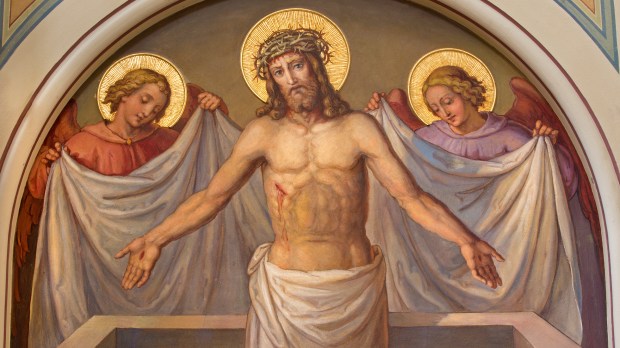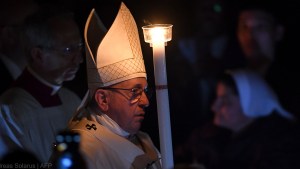Christ is the Way of heaven and earth in all of its senses: He is the communion of God and man, of God’s place and man’s place, of the spiritual and the physical in the world, and, finally, of spirit and flesh in man. It is the fourth communion which becomes clearest in light of Easter.
The Resurrection of Jesus from the dead is the vindication of Christ as God, of his Way as the only way to the Father, and of his cross as our only hope in the face of sin and death. St. Paul tells us that “if Christ has not been raised, then our proclamation has been in vain and your faith has been in vain. … Your faith is futile and you are still in your sins” (1 Cor.15:14, 17).
The Resurrection is also a stunning embrace of the humanbody. “I am always astonished at the emphasis the Church puts on the body,” Flannery O’Connor once wrote. “It is not the soul she says that will rise but the body, glorified.” Christ rises in a glorified way; he can appear and disappear in a moment and pass through locked doors, but he isn’t a pure spirit. He eats food as before and can be seen and touched with the senses: “Look at my hands and my feet; see that it is I myself. Touch me and see; for a ghost does not have flesh and bones as you see that I have” (Luke 24:39). The flesh, to use Tertullian’s phrase, has become the very “hinge” of salvation.
St. Paul, in that same letter to the Corinthians, ties Christ’s Resurrection within history to the general resurrection at the end of history. Jesus is “the first fruits of those who have died” (1 Cor. 15:20); as he rose from the dead in a glorified body, and so too will those who believe in him and follow him. As Augustine put it, the “death of death” we see in Christ, the Head of the Church, will one day be fulfilled in the members of his Body also.
Christ’s Resurrection thus reveals to us our ultimate destiny in Christ: eternal life in a “spiritual body” (1 Cor. 15:44). The two “sides” of man—the spirit and the flesh—continue to be separated by death, just as sin continues to wreak its havoc on the earth, but God has definitively overcome the gulf.
It also reveals to us our true nature: we are both spirit and flesh, both soul and body — a microcosm of both the spiritual and physical dimensions of the cosmos. For the ancient world, there was a great temptation, especially through Gnosticism, to understand man as a mere spirit trapped in flesh. We are “sparks” of divinity awaiting our escape from the prison of the body in death.
In the modern world, we face the opposite, more materialist, temptation: to understand man as a mere body with only the appearance of spirit. On this view, we’re not imprisoned until life after death; we’re free until death after life.
The first option leaves us in dread of the body, the second in dread of its demise. It is on the Way that we see the truth: We’re not spiritual beings having a bodily experience, as the spiritualists think, nor bodily beings having a spiritual experience, as the materialists argue; we’re embodied spirits experiencing the paradox of our dual nature.
The Resurrection, as Bishop Barron says, is “the be-all and end-all of the Christian faith.” To reduce it to a myth or spiritual symbol is to miss the whole point of the Good News, which all of the Apostles—with the exception of John, the guardian of Christ’s mother — went to their deaths proclaiming: Christ is risen; indeed, he is risen, alleluia!
As such, it’s also the culmination of the great both/and begun in the Incarnation, and it reveals the nature, purpose, and dignity of humanity to itself. “Only in the mystery of the incarnate Word,” taught the Second Vatican Council, “does the mystery of man take on light.” Christ is the Way of heaven and earth, both the destination and the road to get there—and it’s only in walking his Way that we’ll ever find ourselves.



